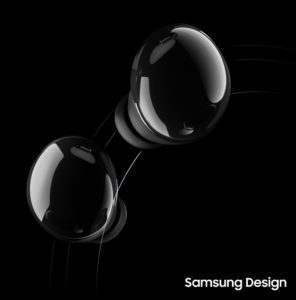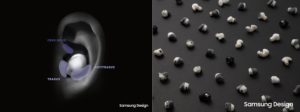 A common adage in modern design is that “form follows function,” meaning that the design process should start with a product’s intended functionality rather than any aesthetic stimulation. This same principle was applied to Galaxy Buds Pro by the Samsung Electronics design team, who understood that wireless earphones must first and foremost provide the best possible experience to users.
A common adage in modern design is that “form follows function,” meaning that the design process should start with a product’s intended functionality rather than any aesthetic stimulation. This same principle was applied to Galaxy Buds Pro by the Samsung Electronics design team, who understood that wireless earphones must first and foremost provide the best possible experience to users.
The resulting design elements of Galaxy Buds Pro are the product of extensive research into the nature of wireless earbuds, their users, and usage habits. Galaxy Buds Pro’s rounded shape with minimal external resistance was designed for optimal sound quality, while their ergonomic design makes for comfortable use and the application of sustainable materials to the product encourages environmentally-friendly processes.
Thanks to the efforts of the designers, Galaxy Buds Pro’s design delivers better earbud experiences by prioritizing function, as well as form.
Capturing sound
To mitigate the prevailing issues that contribute to the degradation of sound quality for wireless earphone users — namely external noise and wind sounds, Samsung’s designers undertook research into reducing these extraneous factors and delivering clearer sound quality. The resulting solution is a curved and rounded overall form factor that streamlines the earbuds to reduce resistance and enhance sound clarity.
The form factor of Galaxy Buds Pro is totally round, with no breaks or protrusions, in order to reduce any wind noise that might occur when wind brushes against the microphone hole. Galaxy Buds Pro’s aerodynamic design, snug inner-ear fit and noise-cancelling technologies help reduce unwanted noise and provide subtle, uninterrupted audio experiences.
Furthermore, today’s wireless earphones are used not just for listening, but for speaking, too, given the convenience they offer when a call comes through and a user’s hands are busy. In order to provide optimized sound capture experiences, too, Samsung’s designers comprehensively designed the internal structure of Galaxy Buds Pro to ensure the earbuds pick up sound as effectively as they produce it.
A carefully-considered distance between Galaxy Buds Pro’s two microphones and the application of beam-forming technology ensure that the earbuds vividly capture the user’s voice without interference.
“We considered the structure of both Galaxy Buds Pro’s exterior and its interior in order to provide the best sound quality, cooperating closely with the engineering department in order to provide the maximum user experiences within the smallest form,” noted the design team.
Ergonomic fit
These days, wireless earphones are becoming more and more indispensable to their users, regardless of location, activity or time of day. Accordingly, the design team devised a size and shape for Galaxy Buds Pro that is suitable for any ear and every moment.
To create a design capable of comfortably suiting all types of ear size and shape, designers conducted earphone comfort surveys and researched the topic extensively in order to create several prototypes and mock-ups and find the optimal earbud design. “Our goal was to provide a fit that is stable and comfortable for as many users as possible,” noted the design team. “Based on our research of individuals with all kinds of ear shapes, we were able to define our optimum standard fit.”
 Sustainable processes
Sustainable processes
The hallmarks of a well-designed product include good aesthetics, novel functionalities and value that goes beyond the product itself. Regarding the latter, Samsung’s designers ensure that all their designs include long-term perspectives that consider every aspect of the product’s lifecycle, from the planning stages through to disposal. In order to provide customers with a product that promotes causes greater than just the intended function, Galaxy Buds Pro have been designed with a sustainable product cycle, as well as with sustainable materials.
As with their predecessors Galaxy Buds Live, Galaxy Buds Pro feature the application of post-consumer materials (PCM) to their body and case. As such materials are recycled from end-of-life plastic, the harmful effects resulting from new plastic production can be reduced through the use of PCM. Galaxy Buds Pro’s designers were also careful to ensure that these sustainable materials were in no way fragile and offered optimized durability and aesthetic quality.
“Taking into account the strength and durability of the product, Galaxy Buds Pro feature 20% PCM,” highlighted the design team. “Given that Galaxy Buds Pro is not a single-use product, we worked hard to balance product longevity with sustainability. We will continue to work hard on devising sustainable product processes that extend even past the end of a product’s lifecycle.”
Learn more here.
Filed Under: News


Questions related to this article?
👉Ask and discuss on Electro-Tech-Online.com and EDAboard.com forums.
Tell Us What You Think!!
You must be logged in to post a comment.